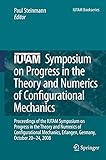IUTAM Symposium on Progress in the Theory and Numerics of Configurational Mechanics / edited by P. Steinmann.
Tipo de material: TextoSeries IUTAM Bookseries ; 17Editor: Dordrecht : Springer Netherlands, 2009Descripción: recurso en líneaTipo de contenido:
TextoSeries IUTAM Bookseries ; 17Editor: Dordrecht : Springer Netherlands, 2009Descripción: recurso en líneaTipo de contenido: - texto
- computadora
- recurso en línea
- 9789048134472
- QC1-999
Springer eBooks
On Discontinuities of Material Momentum and Eshelby Stress in Hyperelasticity and Thermoelasticity -- On a Constraint-Based Regularization Technique for Configurational r-Adaptivity and 3D Shape Optimization -- Some New Properties of the Eshelby Stress Tensor -- On Configurational Aspects of Finite Deformation Inelasticity: A Variational Approach Versus the Transformation of Balance of Momentum -- Configurational Forces Derived from the Total Variation of the Rate of Global Dissipation -- On Crack Analysis of Functionally Graded Materials with Material Forces -- Momentum and Material Momentum in Superconductors -- Dislocations, Microforce and Micromomentum in Second Order Finite Elasto-Plasticity -- A Variational Framework for Dual Solutions in the Physical and Material Space -- On the Nonlocal Symmetries, Group Invariant Solutions and Conservation Laws of the Equations of Nonlinear Dynamical Compressible Elasticity -- Configurational Forces in the Theory of Two-Phase Plates -- On Configurational Formulations in the Director Theory of Rods -- Macroscopic Elasticity of Nanoporous Silicon: Bulk and Surface Effects -- Internal Variables and Generalized Continuum Theories -- Stratified Energies: Ground States with Cracks -- Crack Curving Based on Configurational Forces and Their Gradients -- Anisotropic Elasticity of Grade Three: Conservation and Balance Laws -- Evaluation of Crack-Driving Forces at Finite Viscoelasticity: Theory and Experiment -- On Configurational Forces within Green—Naghdi Thermo-Hyperelasticity -- Translational Conservation and Balance Laws in the Gauge Theory of Dislocations -- Configurational Forces in Continuous Theories of Elastic Ferroelectrics -- A Variationally Consistent Approach for Crack Propagation Based on Configurational Forces -- Computational Homogenization of Defect Driving Forces -- On the Computation of Configurational Forces in Anisotropic Hyperelastic Solids.
Configurational mechanics has attracted much attention from various research fields over the recent years/decades and has developed into a versatile tool that can be applied to a variety of problems. Since Eshelby's seminal works a general notion of configurational mechanics has evolved and has successfully been applied to many problems involving various types of defects in continuous media. The most prominent application is the use of configurational forces in fracture mechanics. However, as configurational mechanics is related to arbitrary material inhomogeneities it has also very successfully been applied to many materials science and engineering problems such as phase transitions and inelastic deformations. Also, the modeling of materials with micro-structure evolution is an important field, in which configurational mechanics can provide a better understanding of processes going on within the material. Besides these mechanical, physical, and chemical applications, ideas from configurational mechanics are now increasingly applied within computational mechanics. In this regard, in particular the combination of configurational mechanics and the finite element method has a notable impact on computational mechanics. New methods based on configurational mechanics are developing in computational fracture mechanics, structural optimization and adaptivity. These methods include, for example, r- and h-adaptive methods for mesh optimization and refinement. The IUTAM Symposium on "Progress in the Theory and Numerics of Configurational Mechanics" that took place at the University of Erlangen/Nuremberg, Germany, from October 20th to 24th, 2008, shed light on the most recent state of affairs in configurational mechanics. This proceedings volume brings together a number of peer reviewed papers that were presented at the symposium.
Para consulta fuera de la UANL se requiere clave de acceso remoto.


